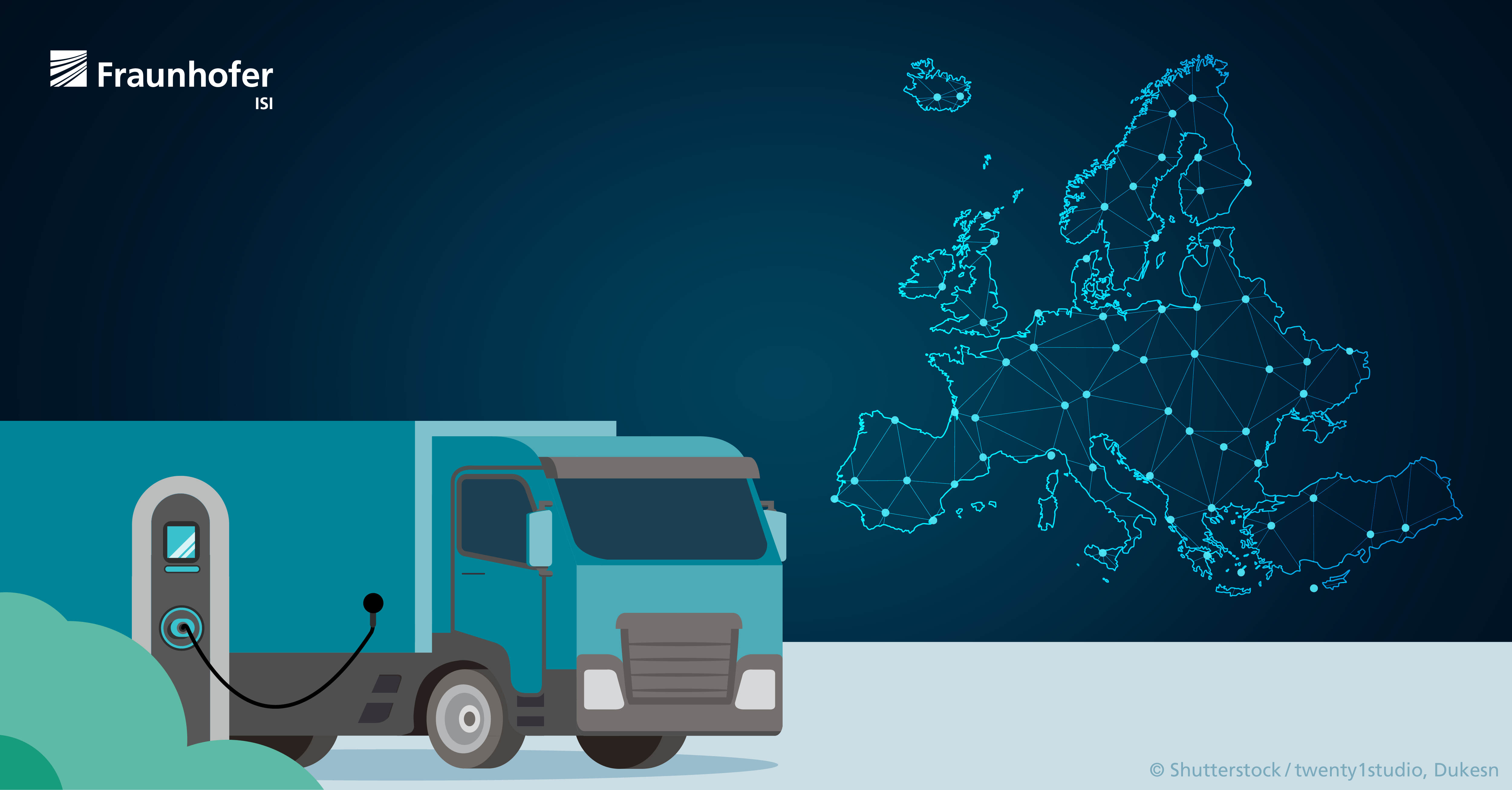Electric trucks: How many fast-charging locations are needed in Europe?
A new joint study by Fraunhofer ISI and Amazon provides critical insights as to the optimal number and location of public fast-charging stations required to enable the widespread electrification of long-haul trucking in Europe. Using traffic flow estimates for 2030, the study built on Amazon’s open-source CHALET tool to analyse 20,000 potential public truck charging locations along the major European highways and a large data set of 1.6 million truck trip combinations. The results suggest that just 1,000 charging stations equipped with Megawatt Charging System (MCS) outlets could enable about 91% of expected long-haul trucking traffic.

To reduce greenhouse gas emissions from transport in general and from heavy-duty trucks in particular, it is mandatory for all EU Member States to deploy infrastructure for alternative fuels in the coming years. This includes the deployment of public fast-charging infrastructure for trucks along motorways. An EU regulation has already set concrete minimum targets regarding public truck charging infrastructure for all EU Member States: for instance, Germany must have a total of approximately 300 locations by 2030 and more than 2,000 truck charging locations are required across the whole of Europe by 2030. However, the limited range of battery-electric trucks compared to today's diesel vehicles, raises the question of how many fast-charging locations are needed in Europe.
To date, little is known about optimal truck charging locations for long-haul trucking in Europe. To shed some light on this, the study suggests optimized truck charging networks consisting of publicly accessible locations across the continent. Based on European truck traffic flow estimates for 2030, and actual truck stop locations, a long-term minimum charging network was created that covers the expected charging demand. The study also considered local capacity constraints and calculates an optimized step-by-step network expansion along the routes with the highest demand in Europe.
About 1,000 charging locations could cover almost all truck traffic in Europe
The key findings show that for an electrification target of 15% battery electric truck (BET) share in long-haul, 1,000 optimally selected charging locations could enable 91% of truck traffic while 500 locations would allow for about half of truck flows. This result is particularly surprising, as the number of suggested locations is smaller than the minimum infrastructure targets required by the European Union. In addition, the authors assumed no depot charging and only 400 km of real-world range which some newly available commercial battery truck models already exceed.
In terms of the optimal locations for truck charging hubs in Europe, the study recommends high-traffic routes, with locations concentrated at major intersections and corridors. As the network expands, additional locations would be added to cover less trafficked routes.
The need for fewer but higher power stations for fast battery truck transition
Dr. Patrick Plötz, Coordinator of the Business Unit Energy Economy at Fraunhofer ISI and author of the study said: “These results show that even fewer locations than required by the European Union would enable almost all European truck traffic. However, the locations that are built will need to secure sufficient grid power, with some sites requiring up to 12 megawatts of grid capacity to support up to 20 MCS outlets. This highlights the significant energy requirements and grid infrastructure needed to support the electrification of Europe's commercial trucking sector at scale; several European Governments are already actively working on this challenge.”
Patrick Plötz concludes that a strategically planned network based on megawatt charging could significantly support the adoption of battery electric trucks in Europe: “This research suggests that industry needs to accelerate development and adoption of megawatt charging systems like MCS, as this enables logistics operators who do not have access to depots to effectively electrify their fleets. Commercialization of MCS can avoid the cost and complexities of securing external real estate and power, which are critical barriers to the total cost of ownership for battery electric trucks.”
Further information
The study is part of the HoLa project which is being funded by the German Federal Ministry for Digital and Transport as part of the electric mobility funding guideline with a total of 12 million euros and is being conducted as a technology and test project in the context of implementing the “Overall Approach to Climate-Friendly Commercial Vehicles”. Funding for this measure is also provided as part of the German Recovery and Resilience Plan (GRRP) via the European Recovery and Resilience Facility (RRF) in the “Next Generation EU” program. The funding guideline is coordinated by NOW GmbH and implemented by Project Management Jülich (PtJ).
The analysis used Amazon’s open-source CHALET tool which was developed to help industry, governments, and local authorities identify optimal locations for electric truck charging infrastructure. It takes into account factors such as traffic flows, vehicle range, and transit times to identify priority locations for eHGV charging points to accelerate the move to sustainable transportation.
- Paper on IOPscience
- Download data set with further information on potential locations for e-trucks
- Cross-cutting topic “Electric mobility“
- Download “European Truck Parking Locations“
- Description of the data set on “European Truck Parking Locations“
- Download “Synthetic European road freight transport flow data based on ETISplus“
- Description of the data set on “Synthetic European road freight transport flow data based on ETISplus“
- Download “Open-Source-Code Amazon CHALET Charging location for electric trucks“
- Backround of Amazon's “Open-Source-Code Amazon CHALET tool“
Always up-to-date
The Fraunhofer Institute for Systems and Innovation Research ISI analyzes the origins and impacts of innovations. We research the short- and long-term developments of innovation processes and the impacts of new technologies and services on society. On this basis, we are able to provide our clients from industry, politics and science with recommendations for action and perspectives for key decisions. Our expertise is founded on our scientific competence as well as an interdisciplinary and systemic research approach.